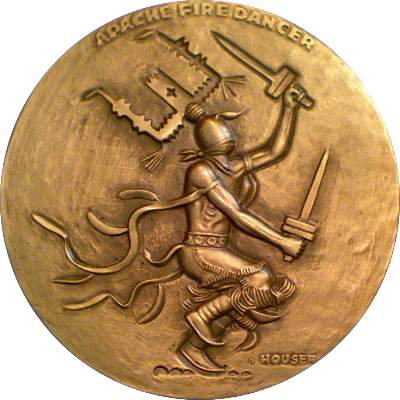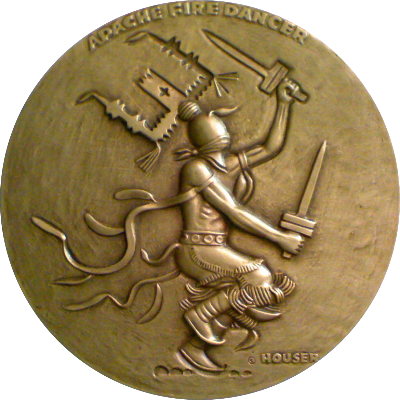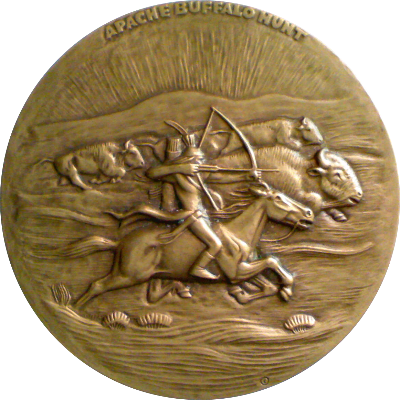Sam and Blossom Haozous were members of the Chiricahua Apache tribe that had been held as prisoners of war since Geronimo's 1886 surrender. After their release from 27 years of captivity, they chose to settle down in Oklahoma, where they had been held. They acquired 160 acres of land near Lawton, Oklahoma and planted cotton and alfalfa. Their son Allan was born in 1914, the first child from his tribe to be born out of captivity. He attended Boone Public School in Boone, Oklahoma but left high school to help out on the family farm. In addition to the regular farmwork he also supported his family by growing vegetables and raising livestock.
Houser developed an early interest in art and began to create drawings and small carvings. In 1934, at the age of 20, Houser left Oklahoma to study at Dorothy Dunn's Art Studio at the Santa Fe Indian School in Santa Fe, New Mexico. Dunn's method encouraged working from personal memory, avoiding techniques of perspective or modeling, and stylization of Native iconography. For the latter, Houser made hundreds of drawings and canvasses in Santa Fe and was one of Dunn's top students, but he found the program too constricting.
In 1939, Houser began his professional career by showing work at the 1939 New York World's Fair and the Golden Gate International Exposition. He received his first major public commission to paint murals at the Main Interior Building in Washington, DC and completed this commission with Navajo painter Gerald Nailor with whom he shared a studio in Santa Fe. He also married Anna Maria Gallegos of Santa Fe, his wife for 55 years. In 1940, he received another commission with the US. Department of Interior to paint life-sized indoor murals, then returned to Fort Sill to study with Swedish muralist Olle Nordmark, who encouraged Houser to explore sculpture. He made his first wood carvings that year.
World War II interrupted Houser's life and career path, and he moved his growing family to Los Angeles where he found work in the L.A. shipyards. Houser worked by day and continued to paint and sculpt by night, making friends among students and faculty at the Pasadena Art Center. Here, he was first exposed to the streamlined modernist sculptural statements of artists like Jean Arp, Constantin Brâncuși, and the English sculptor Henry Moore. These three men – along with the English sculptress Barbara Hepworth, who was among the first sculptors to place sculptural voids within the solid planes of her works - would come to have a huge influence on Houser.
After World War II, Houser applied for a commission at the Haskell Institute in Lawrence, Kansas. Haskell, a Native American boarding school, had lost many graduates to the war and wanted a sculptural memorial to honor them. Though Houser had been carving in wood since 1940, he had never before sculpted in stone. He convinced the jury with his drawings and his conviction, and completed the monumental work Comrade in Mourning from white Carrara marble in 1948. It has become an iconic work, both for the artist and for Native American art in general.
In 1949, Houser received a Guggenheim Fellowship in sculpture and painting, which granted him two years to work on art and still provide for his family. By 1951, as the Fellowship came to an end, Houser had three sons that he needed to support so he accepted a job as an art teacher at the Intermountain Indian School in Brigham City, Utah. Primarily a Navajo boarding school, the Intermountain Indian School was where Houser began to build the teaching part of his legacy, with generations of students working directly with the man to learn the skills, techniques, patience, and tenacity that he brought to his life and work.
The Intermountain years gave Houser a time to teach, raise a family, and focus on his painting. He completed hundreds of paintings there, experimenting with watercolors, oils, and other media. While at Intermountain, he also worked as a children's book illustrator, providing drawings and paintings for seven titles - including an illustrated biography on the life of his granduncle Geronimo.
In 1962, Houser was asked to join the faculty of a new Native American art school, the Institute of American Indian Arts (IAIA). He returned to Santa Fe with his family to head up the Institute's sculpture department. Casting his first bronzes in 1967, Houser was student and teacher as well, bringing forth his own history and ideas for a student body culled from every corner of Native America. He began working with the iconographies of other tribes, using modernist sculptural influences to forge the tribal and the abstract into a visual lexicon all his own. During the early 1970s, Houser continued to teach at the Institute and began the rigorous production and exhibition cycle for which he became well known. As head of the sculpture department, he felt compelled to work in as many sculptural media as possible, evidenced by his solo exhibition of stone, bronze, and welded steel sculptures at the Heard Museum in Phoenix, Arizona in 1970. The following year, Houser exhibited paintings and sculpture at the Philbrook Museum of Art in Tulsa, and in 1973 was awarded the Gold Medal in Sculpture at the Heard Museum Exhibition.
Exhibitions, awards, and accolades continued. In 1975, he was asked to paint the official portrait of former U.S. Secretary of the Interior Stewart Udall. That same year, he had a solo exhibition at the Governor's Gallery at the State Capitol in Santa Fe. After thirteen years at IAIA, Houser retired from full-time teaching to devote himself to sculpture.
Houser's retirement in 1975 marked the beginning of the most prolific stage of his career. With time, materials, and the family compound in southern Santa Fe county, Houser honed the visual language that was to become his artistic legacy. Fusing Native subject matter with the abstract forms and sculptural voids of his modernist peers, Houser carried the mantle of both Native American and Modernism to new levels, bringing forth such memorable images as the Lead Singer, Abstract Crown Dancer, and The Mystic.
Houser also continued to produce remarkable figurative pieces as well, including the life-sized bronze work Chiricuhua Apache Family, dedicated in 1983 at the Fort Sill Apache Tribal Center in Apache, OK. The piece honored both the memory of his parents, Sam and Blossom, and commemorates the 70th anniversary of the release of his tribe's prisoners-of-war from Fort Sill.
Houser's work was explored in a series on American Indian artists for the Public Broadcasting System (PBS). Other artists in the series included R. C. Gorman, Helen Hardin, Charles Loloma, Joseph Lonewolf, and Fritz Scholder. In 1985, Houser's monumental bronze Offering of the Sacred Pipe was dedicated at the U.S. Mission to the United Nations in New York City A year later, he made a bronze bust of Geronimo to commemorate the hundredth anniversary of the surrender of the Chiricuhua Apaches. A cast of the bust was later presented to the National Portrait Gallery, where it remains in the permanent collection. Houser's works, be they in stone, bronze, steel, or gouache, always depicted tribal subjects like Apache mothers and children, Navajo shepherds, or Plains chieftains. The women were in their traditional roles as mothers and sustainers, the men as hunters, warriors, or musicians. In Houser's own words:
"I work not just for myself, but to honor the American Indian. I hope to draw attention to centuries-old values, especially concepts of living in harmony with nature that can beenfit all people."
In his last five years, Houser produced a remarkable number of pieces, and received many awards for his life's work. In 1989 he dedicated As Long as the Waters Flow, a monumental bronze commissioned for the Oklahoma State Capitol building in Oklahoma City. In 1991, he presented a casting of a bronze Sacred Rain Arrow to the Smithsonian Institution. In the dedication before the US Senate Select Committee on Indian Affairs, he dedicated the work to the American Indian. And in 1992, he became the first Native American to receive the National Medal of Arts, awarded at a ceremony at the White House by President George H. W. Bush.
In 1993, Houser was honored by the dedication of the Allan Houser Art Park at the Institute of American Indian Arts, and in 1994, he returned to Washington, DC. for the last time to present the United States government with the sculpture May We Have Peace, a gift, he said, "To the people of the United States from the First Peoples." The gift was accepted by First Lady Hillary Rodham Clinton for installation at the Vice President's residence.
Allan Houser died in Santa Fe, New Mexico, at the age of eighty in August 1994.
Largest portions from Wikipedia.




